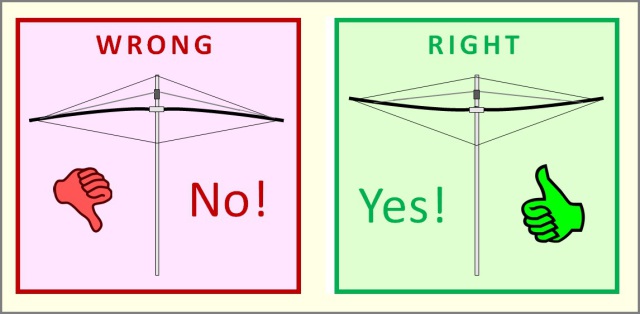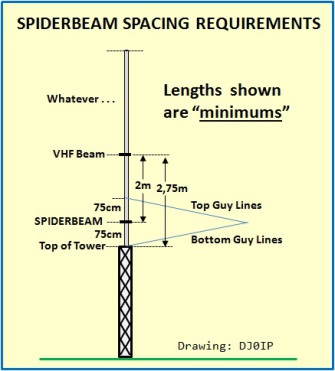Spiderbeam Installation Tips
It is very important to mount the arms in the correct configuration. Unfortunately many people do not think about the consequencies of mounting
the arms wrong. Mounting them wrong can lead to breakage!
The inner ends of the fiberglass arms are open, the outter ends have a cap.
Thus water can run in and out on the inner end, but not on the outer end.
The picture below shows the correct way to guy the fiberglass arms:
Drawings by DJ0IP
THIS IS THE WRONG WAY!
When the arms are drooping down at their ends, water can fill up inside and run to the outer ends of the fiberglass arms where the rubber cap prevents it from running out.
- This adds additional weight to the antenna.
- In winter, this can turn to ice and burst the fiberglass tubes.
THIS IS THE RIGHT WAY!
When the arms are pulled slightly up at their ends, the rubber cap prevents water from running in at the tips, and any water that gets in will run back out on the mast-end of the arms.
Note: the arms should only be slightly up at the ends. Do not pull them too far up, as this puts unnecessary strain on the fg tubes.
GUY ROPES AND LINES:
It is important to adjust all of the ropes and lines correctly.
Top (Kevlar) Guy Ropes: These must be very tight, pulling the arms slightly undward at their far ends. Do not pull the tips too far up. They should only be high enough so that water will run backwards towards the open end near the mast.
Bottom (Kevlar) Guy Ropes: These can be slightly loose. Normally they have no function. In strong gusts of wind, these bottom guy ropes prevent the fiberglass arms from blowing upwards too far. Without these bottom guy ropes, the fiberglass tubes can break more easily in a storm.
Element Guy (PVDF) Lines: These lines should be "snug". This means "just a little bit tight." By keeping them properly tensioned, the fiberglass arms do not dance around so much in the wind. If they are too loose, they can tangle with each other in strong winds.
Driven Element (Twinline) Feedlines:
These are the feedlines made by paralleling the two CQ-532 wires and fastening with heat-shrink tubing. It is important to mount these correctly!
Tension: These feedlines should NOT be under tension. They should be mounted slightly loose, with a just little bit of play in the line.
Instructions for use in High Winds Areas:
There are special instructions for additional support when using a Spiderbeam Yagi antenna in areas with very high winds. You will find two documents on this topic near the bottom of the list of "Tips" on the Construction Tips page. They are called "Clamp Mod...High Winds" and are: HERE
VERTICAL SPACING
Most Important: Guy Ropes:
- 45mm Standpipe (1.5m long)
- Top Guys: 75cm (30 in.)
- Bottom Guys: 75cm
- 35mm Standpipe (1.2m long)
- Top Guys: 70cm (28 in.)
- Bottom Guys: 50cm (20 in.)
VHF/UHF BEAM: 2m above Center Hub
VHF/UHF Vertical: Base 2m above C. Hub
- (if no radials, it can be a little closer)




























